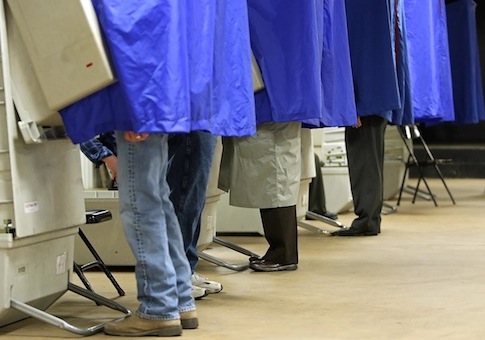The total number of white voters in the 2012 election dropped from 2008 levels while the turnout rate of black voters exceeded that of white voters for the first time, according to the results of the Census Bureau’s 2012 election survey.
Turnout among white voters dropped by about two million between 2008 and 2012, according to the survey, marking the first drop in voter totals for any of the four major ethnic groupings since the Census Bureau started conducting the survey in 1996.
Black voters steadily increased their turnout rate by 13 percent between 1996 and 2012, reaching 66.2 percent. White voters increased their turnout rate by only 3.4 percent over the same 16-year period, reaching 64.1 percent in 2012 from 60.7 percent in 1996.
The turnout of white voters peaked in 2004 at 67.2 percent. It dropped by about one point in 2008 and then by another two points between 2008 and 2012.
Hispanics increased their turnout rate by about 4 points over the same period, and Asians increased theirs by about 2 points, although their turnout was far below that of blacks and whites—48 and 47.3 percent, respectively, in 2012.
While turnout rates have been shifting over the past 20 years, the shape of the electorate has also been changing, according to the bureau’s data.
White voters made up 79.2 percent of the electorate in 1996, while blacks and Hispanics made up 11.9 and 6.1 percent, respectively. By 2012, white voters comprised 71.1 percent of the electorate, while blacks were 12.5 percent and Hispanics 10.8 percent.
The Census Bureau’s data differs from exit polls in that the bureau calls voters in the days after the election and asks whether they voted. Unlike exit polls, the bureau does not collect partisan voting outcomes. The bureau also collects data from all 50 states, while exit polls do not extend across the country.
This "recall" procedure tends to produce slightly higher numbers than the actual voting results due to survey errors and voting mistakes that disqualify ballots, according to voting experts.
Election and demographic experts seized on both the rise in turnout among blacks and the drop off among whites, although they differed in their analyses.
"It’s a landmark finding," said William Frey, a demographics expert at the Brookings Institution. "This puts an exclamation point on the importance of minorities as part of the voting population."
Others wondered if the results of the data could turn out to be more of an outlier in the history of elections.
"Do marginal African voters still turnout without Barack Obama not at the top of the ticket? I don’t know the answer to that," said Sean Trende, a political analyst at Real Clear Politics.
When asked if black voters would continue to vote at the same high levels as they did in 2012, the American Enterprise Institute’s Karlyn Bowman said, "Very hard to know. I’m sure there’s an Obama effect here."
Bowman expressed skepticism that the same level of enthusiasm among black voters would greet the 2016 democratic presidential candidate, whoever it ends up being.
Democrats’ real electoral advantage comes from black voters, said the Weekly Standard’s Jay Cost.
Cost estimated that the increase in black voter support for Democrats, both in total number of black voters and an even larger share of black votes going to Democrats (up to 95 percent from 90 percent), drove much of then-Sen. Obama’s winning margin over Sen. John McCain (R., Ariz.) in 2008.
"Obviously the numbers aren’t good in a lot of respects" for Republicans, said Cost. He said that if blacks continue to turnout at the same rate and support Democrats at the same rate, Republicans will have trouble winning presidential elections.
Frey pointed to the rise of Hispanic voters, combined with increased enthusiasm among blacks, as evidence of Democrats’ advantage moving into the future.
"The sweep of demography is with them," Frey said. He contended that the Republican Party would have to contend for minority voters in order to remain relevant.
Trende agreed Republicans would do well to win Hispanic voters.
However, "at the same time, if they can convince these marginal white voters to turn out at a higher rate … it’s a very close election," he said.
The white voters who failed to turn out were blue collar, poorer, and lived in rural areas, Trende said—the demographic of voter who supported Ross Perot in 1992 and voted for Barack Obama in 2008.
White voter turnout peaked in 2004, the only election since 1988 in which a Republican candidate won the majority of the popular vote.
"I think [George W. Bush] resonated with folks in these downscale areas in ways that Mitt Romney just couldn’t," Trende said.
Cost agreed. He said the 2004 presidential and 2010 midterm elections both tapped into the anxieties of Ross Perot’s supporters.
Cost contested the idea that Hispanics are trending toward being a Democratic constituency, citing Bush’s success with that group in 2004.
Democrats may have been gaining minority voters over the past 20 years, but they have been losing white voters, Cost noted.
"There’s fluidity here on both ends," he said.
Trende objected to the idea that demographics doom the Republican Party.
"It’s much more complicated than the media makes it out to be," he said.
Cost cautioned against extrapolating too much from the bureau’s survey. He noted that Catholics formed a central part of the Democratic base in the early part of the 20th century, peaking with John F. Kennedy’s 80 percent share of Catholics in 1960. However, Mitt Romney won white Catholic voters in 2012.
"You can’t extrapolate things on a straight line going forward," Cost said.
